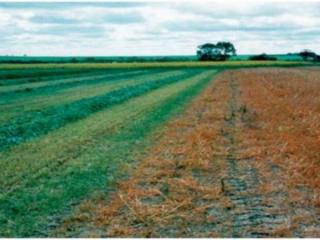Renovation crops and pastures – green manuring, brown manuring, mulching and hay freezing
Renovation crops and pastures are those which are returned to the soil with the key aims of improving soil fertility, reducing weed burdens and increasing soil organic matter. Crops may be returned to the soil by burial, mulching or chemical desiccation.
Green manuring
This incorporates green plant residue into the soil with a cultivation implement. Most commonly conducted with an offset disc plough, cultivation aims to kill weeds and control seed set while building soil organic matter and nitrogen status. Green manuring has a very long history of managing weeds and building soil fertility in systems where herbicides are either not an option or not available, such as organic farming systems.
A problem with green manuring is that cultivation leads to losses of soil organic matter. Further, lighter textured soils may suffer excessive structural damage under green manuring.
The number of tillage passes required by green manuring for a successful kill may be affected by soil moisture.
Brown manuring

This is simply a ‘no-till’ version of green manuring, using a non-selective herbicide to desiccate the crop (and weeds) at flowering instead of using cultivation. The plant residues are left standing. This may also be a preferred option on lighter soils prone to erosion. The standing residues can be grazed after appropriate withholding periods have been observed.
Unlike green manuring, brown manuring impacts positively on soil organic matter. Brown manuring helps retain soil structure and surface cover.
Mulching
This is similar to brown manuring but involves mowing or slashing the crop or pasture and leaving the residue laying on the soil surface. This enables more soil contact with the crop residue and helps reduce soil moisture loss through evaporation. Residues may break down more rapidly as pieces are likely to be smaller than in brown manuring.
Hay freezing
This is similar to brown manuring with the additional aim of creating standing hay. In this case herbicide is applied earlier than if the crop was to be mown for conventional hay making. Hay freezing is a more reliable tactic for controlling weed seed set than conventional hay making, with the added advantage that existing boom sprays are used rather than specialised hay making equipment. The protein content and digestibility of standing hay are similar to those of conventionally baled hay.
Note that the feed value and quantity of hay freezing fodder depend on the plant species and dry matter content of the area treated. Generally, feed value drops rapidly and the treated area needs to be grazed within a few months of spraying to gain most benefit. The protein content and digestibility of fodder following hay freezing deteriorate rapidly after rain, and the fodder suffers trampling losses over time. It does, however, provide and maintain better feed value than hayed-off standing pasture. A glyphosate treated pasture in Western Australia would be expected to maintain good quality for two months after spraying. Plan to graze soon after treatment to avoid the risk of forage quality loss due to weather damage. Strip grazing with an electric or movable fence can reduce trampling loss.
Benefits of renovation cropping
- Manuring, mulching and/or hay freezing (all with regrowth control) reduce viable seed set.
- Manuring will have a beneficial effect on organic matter and soil nitrogen status. The benefit will be greater if the crop or pasture being manured has a high legume content.
- Hay freezing provides standing fodder for livestock.
- Green or brown manuring or hay freezing can be used to manage crop pests and diseases.
- Patches of weeds can be treated prior to the hectic harvest time.
- Costs of renovation cropping (income loss) can be offset by improved yield of subsequent cereal crops.
